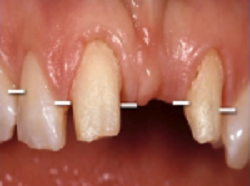The goal of an ovate pontic is to create the illusion that the tooth is emerging from the gingiva with a cuff of tissue surrounding it on the facial. In order to achieve this, it's necessary to identify when an ovate pontic is possible and when it is not.

In fact, the ridge the patient has and whether it is adequate or can be grafted determines the feasibility of an ovate pontic. There are three things we look at in order to decide whether the ridge is adequate, or if it would need augmentation to accommodate the pontic.
Interproximal height

If we drew lines on this patient's photograph between the natural teeth and the height of the papillae in the pontic area, it shows what appears to be a vertically deficient ridge.
The condition of the ridge can be very deceiving however because this particular pontic is sitting on top of the ridge casting a very dark shadow interproximally. To actually evaluate the interproximal height of the ridges, this patient's bridge needed to be removed to expose the real tissue height. After doing that, the tissue was revealed to be adequate in height vertically towards the palatal aspect of the ridge, but deficient in height towards the facial.
Free gingival margin

If we compare the tooth that is present (right central incisor) with the tooth that's missing (left central incisor) it's revealed that the pontic is shorter than the natural tooth. However, the only reason it is shorter is because it's rolled in with an extreme convexity. If this particular pontic had the correct contour, it would be significantly longer than the adjacent tooth.
Facial prominence

The most important view to look at is down from the incisal. Because the tissue has to be facial to the pontic to make it seem like the pontic is emerging out of tissue instead of resting on top of it. The cervical portion of the tooth is where the white line is; the right central and left lateral have at least another 1-1.5mm of gingiva facial to that line. In the pontic area the tissue is lingual to that line, which is causing that dark shadow. This ridge needed to be augmented significantly on the facial to allow an ovate pontic to be created and make the pontic appear like a natural tooth growing out of that tissue.
The augmentation for this patient was done with a connective tissue graft to make the ridge prominent enough to embed the pontic and produce a natural appearance.
Frank Spear, D.D.S., M.S.D., is co-founder of Spear Education and a member of Spear Resident Faculty.
Check out more dental articles by Dr. Frank Spear.